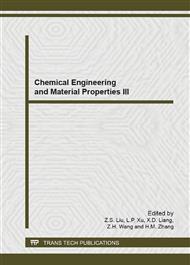p.377
p.381
p.385
p.389
p.393
p.397
p.401
p.405
p.409
Preparation of Chitosan-Diatomite Adsorbent and Adsorption to Cu(II) in Waste Water
Abstract:
The chitosan with the deacetylated degree 95%was mixed with the diatomite in the mass ratio of one chitosan to one point two diatomite to prepare the solid adsorbent for the sorption of the copper wastewater, which was based on the abilities of diatomite to adsorb cations and chitosan to chelate with metal ions. The absorbance of copper ions that were adsorbed before or after the adsorption can be measured at wavelength of 600nm by using spectrophotometer model 722, and both of the adsorption efficiency and capacity can be calculated then. The parameters to influence the adsorption of copper were studied under such conditions as different pH, concentrations, sizes, the sorption temperature and the sorption time. The results show that the adsorption efficiency can reach to 84.3% for 1L copper solution of concentration 0.8mol/L when 1g adsorbents are used at 27°C ,the value of the pH 6 and the sorption time for 1 hour. The cost of the adsorbent is low and it not only could be used to control the pollution of industrial copper wastewater but also provides references to the treatment of other heavy metal wastewater.
Info:
Periodical:
Pages:
393-396
Citation:
Online since:
August 2014
Authors:
Keywords:
Price:
Сopyright:
© 2014 Trans Tech Publications Ltd. All Rights Reserved
Share:
Citation:


